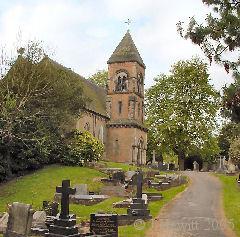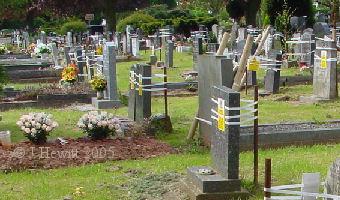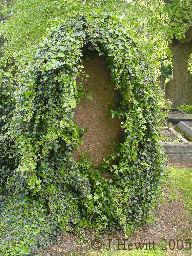

Disappearing Coventry: London Road Cemetery
These pages are devoted to Historic Buildings and areas of Coventry that are suffering from neglect or ill treatment.
If you have any interesting facts and photos to share about historic local buildings, please email me and I shall be happy to add them to my site. (legal stuff: by sending me content to publish you are confirming that you hold copyright of all material and are authorising me to reproduce it on this site.)

Anglican Chapel, London Road Cemetery.
The History of London Road Cemetery Coventry
The Cemetery opened in 1847. It was landscaped by Sir Joseph Paxton at the site of an old quarry near to the old London turnpike. Although an old quarry would not seem like an ideal place for a cemetery, Sir Joseph used the terrain to create a beautiful haven for the dead. The arrangement of trees and curving pathways gives it more the feel of a park; it is often so peaceful that is does not feel as if you are in the middle of a City, or next to the busy London Road and London-Birmingham railway.
Sir Joseph Paxton also designed the Crystal Palace for the Great Exhibition held in 1851 for which he is best known, but to me London Road is a very special place.
At the Cemetery's main entrance there are a Lodge and two chapels, Anglican and Non-Conformist, which were possibly designed by George Stokes, Son in Law of Sir Joseph Paxton. The small Jewish Chapel was a later addition. In the years that followed, two extensions were added to the original cemetery; the first created in 1887, the second in 1929.
The History of London Road Cemetery Coventry
The Cemetery opened in 1847. It was landscaped by Sir Joseph Paxton at the site of an old quarry near to the old London turnpike. Although an old quarry would not seem like an ideal place for a cemetery, Sir Joseph used the terrain to create a beautiful haven for the dead. The arrangement of trees and curving pathways gives it more the feel of a park; it is often so peaceful that is does not feel as if you are in the middle of a City, or next to the busy London Road and London-Birmingham railway.
Sir Joseph Paxton also designed the Crystal Palace for the Great Exhibition held in 1851 for which he is best known, but to me London Road is a very special place.
At the Cemetery's main entrance there are a Lodge and two chapels, Anglican and Non-Conformist, which were possibly designed by George Stokes, Son in Law of Sir Joseph Paxton. The small Jewish Chapel was a later addition. In the years that followed, two extensions were added to the original cemetery; the first created in 1887, the second in 1929.
Reputed descendant of Royalty buried at London Road Cemetery
A local Coventry story exists that Hannah Harrison Lowe was the illegitimate daughter of King George IV and Mrs Fitzherbert. In 2009 a monument was erected at London Road Cemetery by the descendants of Hannah and her husband Samuel Barnes to mark the grave site of their famous ancestor.
With gratitude to Ibrahim Leadley, Hannah's Great-Great-Great Grandson who kindly supplied two photographs I have created a web page with more information about Hannah Harrison Lowe.
Friends of London Road Cemetery
Anyone with relations buried at London Road Cemetery will be delighted to know that there is a group called the Friends of London Road Cemetery. Their aim is to restore the Cemetery and save its historic graves and buildings for future generations. If you are interested why not attend their next meeting? For further details contact The Friends Group. You can visit the friends of London Road Cemetery's website at www.lrcemetery.co.uk

London Road Cemetery, Coventry in 2005.
The history of London Road Cemetery
Please note, this page was originally written way back in 2005. Since then, there has been a happy conclusion to the 'health and safety' issue recorded here for posterity. Do bear this in mind when reading.
If you have relations buried in Coventry’s historic and beautiful London Road Cemetery you will no doubt be upset to see photos of gravestones tied to metal stakes driven into the ground, and defaced by large yellow stickers. Many of these graves are only a few years old, so it is hard to understand how they can be unsafe.
It is interesting to note that the graves which I saw in the older part of the cemetery, many of which actually look unsafe and are leaning at odd angles or collapsing into the graves had not even been looked at yet.
According to a Council safety review, every gravestone was to be tested and many families will be charged £112 to make them safe. This involves laying the gravestones flat on the ground. Many graves have inscriptions on both sides, so it would have meant the tragic loss of information for family research as well as loved one's memorial inscriptions being permanently hidden. There are about 50,000 plots at London Road so many bereaved families were left dealing with the added upset and anticipated extra expense.
The council wrote to the Grave Owners at their last known address, only allowing one month to reply. However some of the graves date from 1847 so it seems unlikely they will have much luck. When relations who no longer live locally visit to pay their respects they may be disturbed or upset at what like damage caused by vandals.

An historic gravestone, obscured and damaged by ivy.
The state of neglect in the old part of the cemetery is very apparent. Ivy covered graves may look attractive, but some stones are completely obscured, so it is hard to judge how much damage the ivy has done to the already delicate stonework.
Update August 2005
Anyone with relations buried at London Road will be please to know that work to fix "unsafe" memorials has for the moment been suspended. This is as a direct result of the many complaints from relations shocked to find gravestones covered in tape or even placed down flat on the ground. The council are at the moment drawing up their own set of guidelines which will hopefully stop the number of recent gravestones being deemed unsafe and many newly bereaved facing large stonemasons bills.
Update April 2006
In a move that will please thousands of bereaved relatives the council are to adopt new procedures set out by the Institute of Cemetery and Crematorium Management. This will mean a more rational approach will be taken in future and wholesale flattening of memorials will stop. a number of factors will now be considered such as the stability of the stone (if it moves when pushed), state of the ground, and size of the memorial. They have pledged to keep relations informed but I feel that although writing to the last know address may work for recent memorials, to contact relations of some of the oldest burials it would be better to list the names in the Coventry local paper as well as making them available on the Council's own Website.
Update October 2006
Coventry Council have at last admitted that their treatment of the recently bereaved with regard to headstone safety was insensitive and heavy handed. Some of those forced to pay for stabilising work at short notice on recent headstones are now to have half of their expenses paid for by the Council, which will no doubt be a great relief. This change heart will be welcomed by many, as is the admission that pervious safety checks were too stringent.
Monday 15th May 2005 Vandal’s damage Historic Cemetery
Vandals have caused thousands of pounds damage to the old part of London Road Cemetery. Nearly 30 graves were attacked some had bricks thrown at them while others were kicked over, flowers were removed and destroyed.
The police said that the vandals had been drinking on the steps of the nonconformist chapel and it was around this area that the damage started. Further damage was then caused as they headed towards Quarryfield Lane.
Tragically the graves affected are some of the oldest in the cemetery, this makes it unlikely that relatives will ever been found and the damage repaired. Anyone who thinks their relative’s graves may be affected can contact Canley Crematorium as they hold records of the vandalised graves, on 024 7629 4400 or 4401.
Coventry: The Making of a Modern City 1939-73 (Informed Conservation) by Jeremy Gould
The Coventry Blitz of 14 November 1940 was a key event of the Second World War and in the growth of public consciousness of the destructive power of warfare. The medieval city, already undergoing rapid change, was largely destroyed on that night. The destruction was seen as an opportunity by some including the then City Architect, Donald Gibson.
The result was the first of the master plans for post-war redevelopment of Britain's bombed city centres. The redevelopment of Coventry city centre to plans by Gibson and his successors provided an intensely urban and civilised centre, embodying new planning principles.
Post-war Coventry was hugely influential and Gibson's ideas helped to shape the rebuilding of other city centres, the post-war new towns and developments in Europe. Despite incremental change in the subsequent decades the planning and architecture of Gibson's city centre are still clearly legible. The modern demands of a growing city on its centre are now very different from those of the post-war years.
Coventry needs to grow and plan for its future and change will inevitably affect the city centre.
This book aims to inform the public and decision makers of the significance of Coventry, and especially its centre, so that change can be managed in ways that will continue the life, use and enjoyment of the best of Coventry's remarkable post-war heritage.

